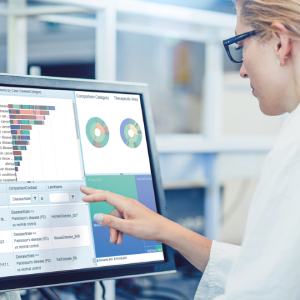














Are you a researcher or data scientist working in drug discovery? If so, you depend on data to help you achieve unique insights by revealing patterns across experiments. Yet, not all data are created equal. The quality of data you use to inform your research is essential. For example, if you acquire data using natural language processing (NLP) or text mining, you may have a broad pool of data, but at the high cost of a relatively large number of errors (1).
As a drug development researcher, you’re also familiar with freely available datasets from public ‘omics data repositories. You rely on them to help you gain insights for your preclinical programs. These open-source datasets aggregated in portals such as The Cancer Genome Atlas (TCGA) and Gene Expression Omnibus (GEO) contain data from thousands of samples used to validate or redirect the discovery of gene signatures, biomarkers and therapies. In theory, access to so much experimental data should be an asset. But, because the data are unintegrated and inconsistent, they are not directly usable. So in practice, it’s costly, time-consuming and utterly inefficient to spend hours sifting through these portals to find the information required to clean up these data so you can use them.
Data you can use right away
Imagine how transformative it would be if you had direct access to ‘usable data’ that you could immediately understand and work with, without searching for additional information or having to clean and structure it. Data that is comprehensive yet accurate, reliable and analysis-ready. Data you can right away begin to convert into knowledge to drive your biomedical discoveries.
Creating usable data
Data curation has become an essential requirement in producing usable data. Data scientists spend an estimated 80% of their time collecting, cleaning and processing data, leaving less than 20% of their time for analyzing the data to generate insights (2,3). But data curation is not just time-consuming. It’s costly and challenging to scale as well, particularly if legacy datasets must be revised to match updated curation standards.
What if there were a team of experts to take on the manual curation of the data you need so researchers like you could focus on making discoveries?
Our experts have been curating biomedical and clinical data for over 25 years. We’ve made massive investments in a biomedical and clinical knowledge base that contains millions of manually reviewed findings from the literature, plus information from commonly used third-party databases and ‘omics dataset repositories. Our human-certified data enables you to generate insights rather than collect and clean data. With our knowledge and databases, scientists like you can generate high-quality, novel hypotheses quickly and efficiently while using innovative and advanced approaches, including artificial intelligence.

Figure 1. Our workflow for processing 'omics data.
4 advantages of manually curated data
Our 200 dedicated curation experts follow these seven best practices for manual curation. Why do we apply so much manual effort to data curation? Based on our principles and practices for manual curation, here are the top reasons manually curated data is fundamental to your research success:
1. Metadata fields are unified, not redundant
Author-submitted metadata vary widely. Manual curation of field names can enforce alignment to a set of well-defined standards. Our curators identify hundreds of columns containing frequently-used information across studies and combine these data into unified columns to enhance cross-study analyses. This unification is evident in our TCGA metadata dictionary unification is evident in our TCGA metadata dictionary, for example, where we unified into a single field the five different fields that were used to indicate TCGA samples with a cancer diagnosis of a first-degree family member.
2. Data labels are clear and consistent
Unfortunately, it’s common that published datasets provide vague abbreviations as labels for patient groups, tissue type, drugs or other main elements. If you want to develop successful hypotheses from these data, it’s critical you understand the intended meaning and relationship among labels. Our curators take the time to investigate each study and precisely and accurately apply labels so that you can group and compare the data in the study with other relevant studies.
3. Additional contextual information and analysis
Properly labeled data enables scientifically meaningful comparisons between sample groups to reveal biomarkers. Our scientists are committed to expert manual curation and scientific review, which includes generating statistical models to reveal differential expression patterns. In addition to calculating differential expression between sample groups defined by the authors, our scientists perform custom statistical comparisons to support additional insights from the data.
4. Author errors are detected
No matter how consistent data labels are, NLP processes cannot identify misassigned sample groups, and such errors are devastating to data analysis. Unfortunately, it’s not unheard of that data are rendered uninterpretable due to conflicts in sample labeling presented in a publication versus its corresponding entry in a public ‘omics data repository. As shown in Figure 2, for a given Patient ID, both ‘Age’ and ‘Genetic Subtype’ are mismatched between the study’s GEO entry and publication table; which sample labels are correct? Our curators identify these issues and work with authors to correct errors before including the data in our databases.

Figure 2. In this submission to NCBI GEO, the ages of the various patients conflict between the GEO submission and the associated publication. What’s more, the genetic subtype labels are mixed up. Without resolving these errors, the data cannot be used. This attention to detail is required, and can only be achieved with manual curation.
At the core of our curation process, curators apply scientific expertise, controlled vocabularies and standardized formatting to all applicable metadata. The result is that you can quickly and easily find all applicable samples across data sources using simplified search criteria.
Dig deeper into the value of QIAGEN Digital Insights’ manual curation process
Ready to incorporate into your research the reliable biomedical, clinical and ‘omics data we’ve developed using manual curation best practices? Explore our QIAGEN knowledge and databases, and request a consultation to find out how our manually curated data will save you time and enable you to develop quicker, more reliable hypotheses. Learn more about the costs of free data in our industry report and download our unique and comprehensive metadata dictionary of clinical covariates to experience first-hand just how valuable manual curation really is.
References:
You need biomedical relationships knowledge for innovative data- and analytics-driven drug discovery. Yet this knowledge is locked in thousands of publications and dozens of databases. Collecting, structuring and integrating this knowledge is a challenging task that is time- and resource-consuming.
What if you could break knowledge silos and confidently power your drug discovery with data science using a high-quality and industry-validated source of structured and integrated biomedical relationships?
We are excited to introduce QIAGEN Biomedical Knowledge Base, the leading knowledge about biomedical relationships, manually structured and integrated from thousands of sources by experts. It is a vast collection of diverse causal relationships between genes, diseases, drugs, targets, functions, toxicological processes and more, all of which are enriched with full context. QIAGEN Biomedical Knowledge Base delivers high-quality data ideally suited for major data science-driven drug discovery applications. These include knowledge graph construction and analysis, analytics- and artificial intelligence (AI)-driven target identification and drug repositioning, development of target, disease and drug intelligence portals, disease subtype and biomarker identification and many more.
QIAGEN Biomedical Knowledge Base fuels QIAGEN Ingenuity Pathway Analysis (IPA), our premier ‘omics data analysis and interpretation software. This is data you know well, and now you can access it directly.
"For over 20 years, we have been assembling the world's leading source of molecular knowledge and data used to inform decisions from bench to bedside. This knowledge and data power market-leading products such as QIAGEN IPA, QIAGEN OmicSoft, QCI Interpret and online databases like HGMD and HSMD," said Dr. Jonathan Sheldon, Senior VP of QIAGEN Digital Insights. "Previously, our focus was to make our knowledge and data solely accessible through our industry-leading applications. Now, in addition, we are unlocking and giving the keys to our knowledge and data to fuel drug discovery with data science. The data is in a format and structure that makes it easy to integrate our reliable molecular data into data science projects within pharma and biotech."
Using QIAGEN Biomedical Knowledge Base, you’ll make biomedical discoveries that are:
See how QIAGEN Biomedical Knowledge Base empowers you to leverage biomedical knowledge graph analysis, fuel your data- and analytics-driven drug discovery and transform your research. Learn more and request your trial today.
With the scientific research community publishing over two million peer-reviewed articles every year since 2012 (1) and next-generation sequencing fueling a data explosion, the need for comprehensive yet accurate, reliable and analysis-ready information on the path to biomedical discoveries is now more pressing than ever.
Manual curation has become an essential requirement in producing such data. Data scientists spend an estimated 80% of their time collecting, cleaning and processing data, leaving less than 20% of their time for analyzing the data to generate insights (2,3). But manual curation is not just time-consuming. It is costly and challenging to scale as well.
We at QIAGEN take on the task of manual curation so researchers like you can focus on making discoveries. Our human-certified data enables you to concentrate on generating insights rather than collecting data. QIAGEN has been curating biomedical and clinical data for over 25 years. We've made massive investments in a biomedical and clinical knowledge base that contains millions of manually reviewed findings from the literature, plus information from commonly-used third-party databases and 'omics dataset repositories. With our knowledge and databases, scientists can generate high-quality, novel hypotheses quickly and efficiently, while using innovative and advanced approaches, including artificial intelligence.
Here are seven best practices for manual curation that QIAGEN's 200 dedicated curation experts follow, which we presented at the November 2021 Pistoia Alliance event.
These principles ensure that our knowledge base and integrated 'omics database deliver timely, highly accurate, reliable and analysis-ready data. In our experience, 40% of public ‘omics datasets include typos or other potentially critical errors in an essential element (cell lines, treatments, etc.); 5% require us to contact the authors to resolve inconsistent terms, mislabeled treatments or infections, inaccurate sample groups or errors mapping subjects to samples. Thanks to our stringent manual curation processes, we can correct such errors.
Our extensive investment in high-quality manual curation means that scientists like you don't need to spend 80% of their time aggregating and cleaning data. We've scaled our rigorous manual curation procedures to collect and structure accurate and reliable information from many different sources, from journal articles to drug labels to 'omics datasets. In short, we accelerate your journey to comprehensive yet accurate, reliable and analysis-ready data.
Ready to get your hands on reliable biomedical, clinical and 'omics data that we've manually curated using these best practices? Learn about QIAGEN knowledge and databases, and request a consultation to find out how our accurate and reliable data will save you time and get you quick answers to your questions.
References: